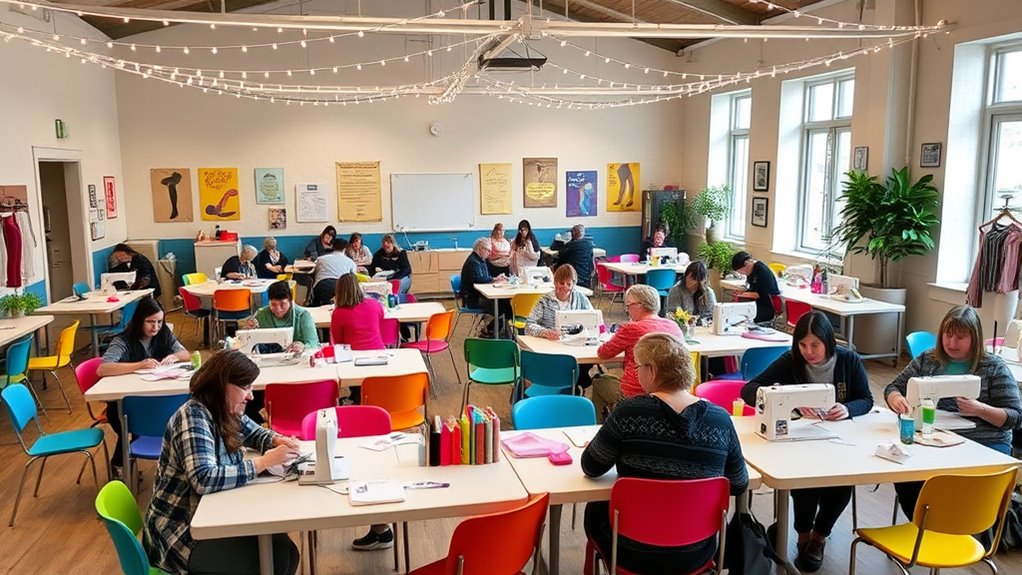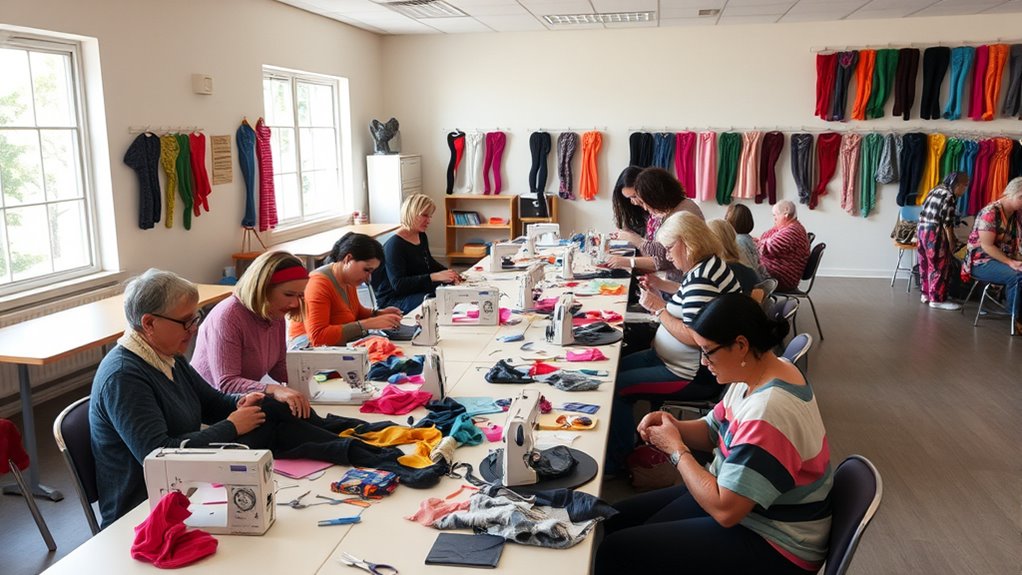To host a tights repair workshop in your community, start by planning clear steps and organizing supplies like needles, matching thread, and fabric scraps. Promote your event through social media, flyers, and partnerships with local shops or libraries. Set up an inviting space with comfortable seating and easy access to tools. During the session, guide participants with simple instructions, encourage creativity, and celebrate their efforts. Keep the environment friendly and structured—if you continue, you’ll discover more tips to make it a success.
Key Takeaways
- Plan the workshop with clear instructions, organize supplies, and define roles to ensure a smooth and engaging experience.
- Promote the event through social media, local partnerships, and community groups to attract participants.
- Set up an inviting space with accessible tools, good lighting, and safety guidelines to foster comfort and confidence.
- Prepare practice materials like tights with minor tears and demonstrate repair techniques step-by-step.
- Encourage creativity by sharing ideas, showcasing unique repairs, and celebrating participant efforts to promote sustainability.
Planning and Organizing Your Workshop

Before you start your tights repair workshop, it’s essential to plan and organize effectively. Begin by crafting clear instructional guides that outline each step of the repair process. These guides will help participants understand what to expect and ensure consistency throughout the workshop. Managing volunteer roles is equally important; assign specific tasks such as greeting attendees, demonstrating techniques, or assisting with repairs. Clear role definitions prevent confusion and keep the event running smoothly. Additionally, determine the workshop’s structure, set a schedule, and decide on the venue. Proper planning not only boosts efficiency but also creates an engaging environment where participants feel confident and supported. Incorporating detailed project planning ensures every aspect of the workshop aligns with your goals. With good organization, your tights repair workshop will be both enjoyable and successful.
Gathering Supplies and Materials

To guarantee your tights repair workshop runs smoothly, gather all necessary supplies and materials ahead of time. You’ll need basic tools like needles, matching thread, and scissors for various repair techniques. Consider including fabric recycling options, such as fabric patches or leftover scraps, to encourage sustainable practices. Make sure to have different types of tights, including those with minor tears and holes, so participants can practice repair techniques suited to each case. Extra magnifying glasses or good lighting can help with intricate repairs. Stock up on fabric glue or patches for quick fixes. Organizing supplies in accessible containers ensures participants can easily grab what they need. Preparing these materials beforehand and understanding the importance of sustainability can help foster a community focused on creative reuse and environmentally conscious practices.
Promoting the Event to Your Community

Promoting your tights repair workshop effectively guarantees a strong turnout and community engagement. Start with social media outreach by creating eye-catching posts that highlight the event’s purpose, date, and location. Use platforms like Facebook, Instagram, and community forums to reach a wider audience. Don’t forget to encourage sharing to increase visibility. Additionally, build local partnerships with nearby shops, libraries, or community centers. Ask them to display flyers or mention your event in their newsletters. Personal invitations through email or community groups also boost attendance. The key is to be clear, enthusiastic, and consistent in your messaging. By leveraging social media and local collaborations, you’ll maximize exposure and foster a sense of community around your tights repair workshop. Ensuring the safety of any equipment or tools used during the workshop, such as electric heated mattress pads, can also help maintain a secure environment for participants.
Setting Up a Welcoming and Effective Space

Creating a welcoming and effective space sets the tone for a successful tights repair workshop. Focus on fostering community engagement by arranging the area to encourage interaction and comfort. Ensure there’s enough seating, good lighting, and accessible tools to make everyone feel at ease. Clearly display safety protocols, such as how to safely handle needles and scissors, to prevent accidents. Keep the workspace organized to minimize clutter, which helps participants feel more confident. Consider using signage or visual cues to guide attendees through the process. A friendly, inclusive environment invites people to share ideas and ask questions. When participants feel comfortable and safe, they’re more likely to fully engage and enjoy the workshop, making it a rewarding experience for everyone involved. Additionally, understanding local laws related to public gatherings can help ensure your event complies with community regulations.
Facilitating the Repair Session and Encouraging Creativity

Once the workshop is underway, guiding participants through the repair process with clear, step-by-step instructions helps build their confidence. To foster collaboration and embody sustainability, encourage everyone to share ideas and techniques. You can also inspire creativity by suggesting alternative repair methods or decorative touches. Here are some ways to enhance the session:
- Demonstrate different repair techniques to spark ideas.
- Invite participants to showcase their unique approaches.
- Provide prompts for creative embellishments or personalization.
- Celebrate every effort, emphasizing learning over perfection.
- Incorporate rustic decor ideas to inspire a cozy, farmhouse-inspired aesthetic in their repairs or embellishments.
Frequently Asked Questions
What Age Groups Should I Target for the Workshop?
You should target a wide age range to maximize participation and impact. Teens might find the workshop engaging with a teen focus, encouraging independence and creativity. Including family involvement can appeal to younger children and parents, creating a supportive environment. By offering activities suitable for teens and families, you foster community bonding and promote sustainable skills. Tailoring your approach guarantees everyone feels welcomed and motivated to learn and repair tights together.
How Can I Handle Difficult or Uncooperative Participants?
Did you know that 85% of people feel more motivated when they’re involved in collaborative activities? When handling difficult or uncooperative participants, focus on conflict resolution and understanding their concerns. Keep a positive, patient attitude, and set clear expectations. Engage them with questions to boost participant motivation, and calmly address issues. Your patience and communication skills will encourage cooperation, creating a welcoming environment for everyone.
What Safety Precautions Are Necessary During Repairs?
When repairing tights, safety precautions are essential. You should wear safety gear like thimbles or gloves to prevent accidental cuts or pin pricks. Maintain hazard awareness by keeping your workspace tidy and handling sharp tools carefully. Always use good lighting, and keep a first aid kit nearby for emergencies. By staying alert and wearing proper safety gear, you safeguard yourself and ensure a safe, enjoyable repair experience.
How Do I Manage Varying Skill Levels Among Attendees?
Managing varying skill levels among attendees requires skill level differentiation, so everyone stays engaged. You can do this by offering beginner-friendly demonstrations alongside advanced tips, and providing different repair techniques suited for different skill sets. Encourage attendee engagement by creating small groups based on skill level and fostering peer support. This way, all participants feel challenged but supported, making the workshop enjoyable and educational for everyone.
What Are Some Eco-Friendly Disposal Options for Damaged Tights?
When considering eco-friendly disposal options for damaged tights, you can encourage attendees to participate in local recycling programs or textile donation initiatives. Recycling programs help break down tights responsibly, reducing waste. Textile donation allows for reuse or repurposing of tights that are still wearable or can be repurposed creatively. Promoting these options helps minimize environmental impact and fosters sustainable habits within your community.
Conclusion
Hosting your tights repair workshop is like planting a seed of creativity and community. As you nurture skills and foster connections, you cultivate a garden of sustainable habits and shared stories. Watch as small stitches grow into stronger bonds, turning simple repairs into symbols of resilience and resourcefulness. In this space, every mend becomes a thread weaving your community closer, reminding everyone that even the tiniest effort can create a tapestry of lasting change.









